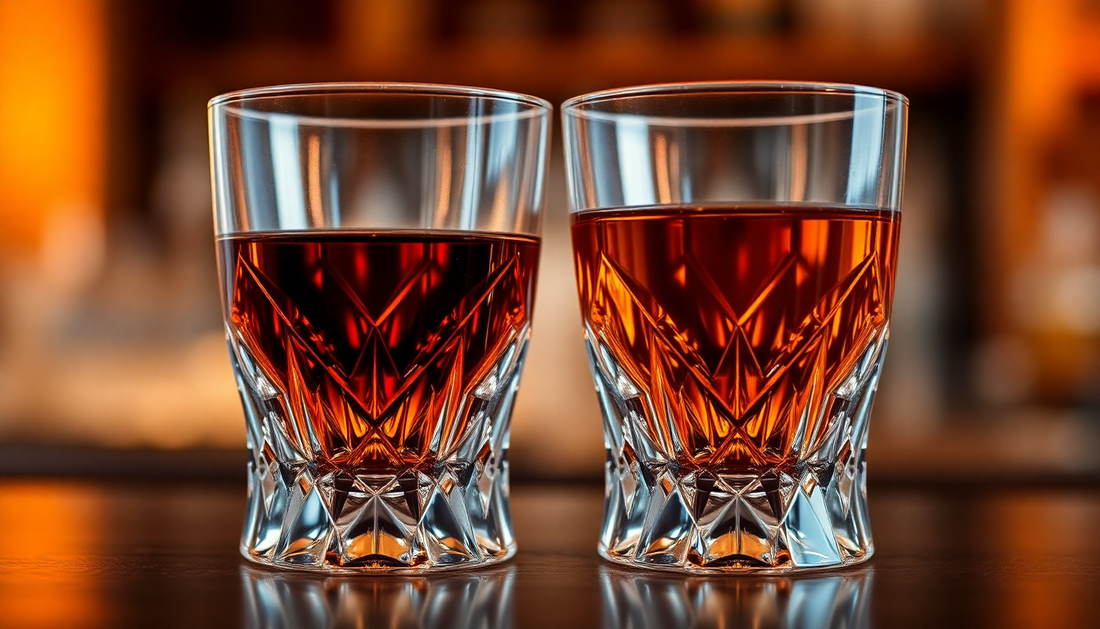
Bourbon VS Rye: 10 Differences Between Them
Share
Learn the difference between Bourbon & Rye with our complete guide:
As whiskey enthusiasts, we're often asked to explain the nuances between bourbon and rye whiskey. Its a new question on many peoples lips, how do they compare? Bourbon VS Rye? While both are beloved American spirits, there are distinct differences that set them apart. In this comprehensive guide, we'll explore 10 key distinctions that will help you better appreciate the unique qualities of each.
Historical Background
Bourbon and rye whiskey have deep roots in American history. Bourbon's origins can be traced back to the late 18th century, when early settlers in Kentucky began distilling corn-based spirits. Meanwhile, rye whiskey has its origins in the Northeast, where European immigrants brought their rye-distilling traditions.
The Birth of Bourbon
Bourbon's rise to fame is closely tied to the fertile lands of Kentucky, where the climate and water sources were ideal for growing corn, the primary ingredient in the spirit. As the demand for this smooth, sweet whiskey grew, Kentucky distillers refined their techniques, leading to the distinct bourbon profile we know and love today.
Rye Whiskey's Northeastern Roots
In contrast, rye whiskey found its footing in the Northeast, particularly in states like Pennsylvania and Maryland. These regions were well-suited for growing rye, a hardy grain that thrived in the cooler climates. Rye whiskey's spicy, complex flavor profile emerged as a result of this regional influence.
Bourbon VS Rye Main Ingredient Differences
The most fundamental distinction between bourbon and rye whiskey lies in their primary grain ingredients.
Bourbon's Corn-Based Mash
By law, bourbon must be made from a mash bill that contains at least 51% corn. This corn-heavy composition lends bourbon its characteristic sweetness and smooth, velvety texture.
Rye Whiskey's Rye-Based Mash
Rye whiskey, on the other hand, must be made from a mash bill that contains at least 51% rye. This spicy, peppery grain imparts a distinct flavor profile to rye whiskey, often described as bold, complex, and full-bodied.
Production Process Variations
The distillation and aging methods used for bourbon and rye whiskey also contribute to their unique characteristics.
Bourbon's Distillation Techniques
Bourbon distillers typically employ column stills, which allow for a higher degree of alcohol concentration and a smoother, more refined spirit. The aging process for bourbon also has strict requirements, with a minimum of two years in new, charred oak barrels.
Rye Whiskey's Distillation and Aging
Rye whiskey producers often use pot stills, which result in a more robust, complex flavor profile. The aging process for rye whiskey is less stringent, with no minimum aging requirement, allowing for a wider range of styles and expressions.
Flavor Profiles
Bourbon VS Rye - The distinct grain compositions of bourbon and rye whiskey translate to vastly different flavor profiles.
Bourbon's Sweet and Smooth Character
Bourbon is known for its sweet, caramel-like notes, often with hints of vanilla, oak, and even fruit. This smooth, approachable character makes bourbon a popular choice for sipping or mixing in classic cocktails.
Rye Whiskey's Spicy and Complex Flavors
Rye whiskey, on the other hand, is characterized by its bold, spicy flavors, with notes of black pepper, cinnamon, and even a touch of mint. This complex, full-bodied profile makes rye whiskey a favorite among those seeking a more assertive, sophisticated spirit.
Alcohol Content
Both bourbon and rye whiskey have specific legal requirements when it comes to their alcohol content.
Bourbon's Alcohol Content
By law, bourbon must be bottled at a minimum of 80 proof (40% ABV), though many premium bourbons are bottled at higher proofs, often reaching up to 120 proof (60% ABV).
Rye Whiskey's Alcohol Content
Rye whiskey, on the other hand, has a slightly wider range, with a minimum requirement of 40% ABV, but can be bottled at proofs as high as 125 (62.5% ABV).
Geographic Distinctions
The production locations of bourbon and rye whiskey also contribute to their unique identities.
Bourbon's Kentucky Roots
Bourbon is intrinsically linked to the state of Kentucky, where the majority of the world's bourbon is produced. The region's limestone-filtered water, temperate climate, and long history of distilling have all played a role in shaping the character of this iconic American spirit.
Rye Whiskey's Diverse Production Locations
While Kentucky is also a significant producer of rye whiskey, the spirit is not as geographically tied to a single region. Rye whiskey is produced in various parts of the United States, including the Northeast, Midwest, and even the West Coast, each imparting its own unique regional influence.
Cocktail Applications
The distinct flavor profiles of bourbon and rye whiskey lend themselves to different cocktail applications.
Classic Bourbon Cocktails
Bourbon shines in timeless cocktails like the Old Fashioned, Mint Julep, and Manhattan, where its sweet, smooth character complements the other ingredients.
Popular Rye Whiskey Drinks
Rye whiskey, with its bold, spicy notes, is the star of cocktails like the Sazerac, Manhattan, and the Old Fashioned (when made with rye instead of bourbon).
Price Points and Availability
The market trends for bourbon and rye whiskey also differ, affecting their availability and pricing.
Bourbon Market Trends
Bourbon has experienced a surge in popularity in recent years, leading to increased demand and higher prices, especially for premium and limited-edition bottlings.
Rye Whiskey Market Trends
Rye whiskey, while gaining more recognition, has generally remained more affordable and accessible compared to its bourbon counterpart, making it an attractive option for whiskey enthusiasts on a budget.
Collector's Perspective
Both bourbon and rye whiskey have their own dedicated collector's markets, with rare and limited-edition bottles commanding high prices.
Rare Bourbon Bottles
Certain vintage and limited-release bourbons, such as Pappy Van Winkle and Buffalo Trace Antique Collection, are highly sought after by collectors and can fetch hundreds or even thousands of dollars per bottle.
Sought-After Rye Whiskeys
While not as widely collected as rare bourbons, exceptional rye whiskeys, such as the Sazerac 18 Year Old and the Michter's 10 Year Old Single Barrel Rye, have also gained a loyal following among discerning whiskey enthusiasts.
Food Pairing Suggestions
The distinct flavor profiles of bourbon and rye whiskey lend themselves to different food pairing opportunities.
Ideal Pairings for Bourbon
Bourbon's sweet, caramel-like notes pair beautifully with rich, decadent foods, such as chocolate desserts, pecan pie, and even barbecue dishes.
Complementary Foods for Rye Whiskey
Rye whiskey's spicy, complex character complements a wide range of savory dishes, including hearty stews, roasted meats, and even certain cheeses.
Conclusion
Bourbon VS Rye; Bourbon and rye whiskey may both be American spirits, but their unique histories, production methods, and flavor profiles make them distinctly different. Whether you prefer the smooth, sweet notes of bourbon or the bold, spicy character of rye, exploring the nuances between these two whiskey styles is a journey worth taking for any true whiskey enthusiast. So, raise a glass and savor the rich diversity of these iconic American spirits.
Not sure what the Best Rye Whiskey is for your palette?
<< Check out our Unbiased Rye Whiskey Reviews here >>

